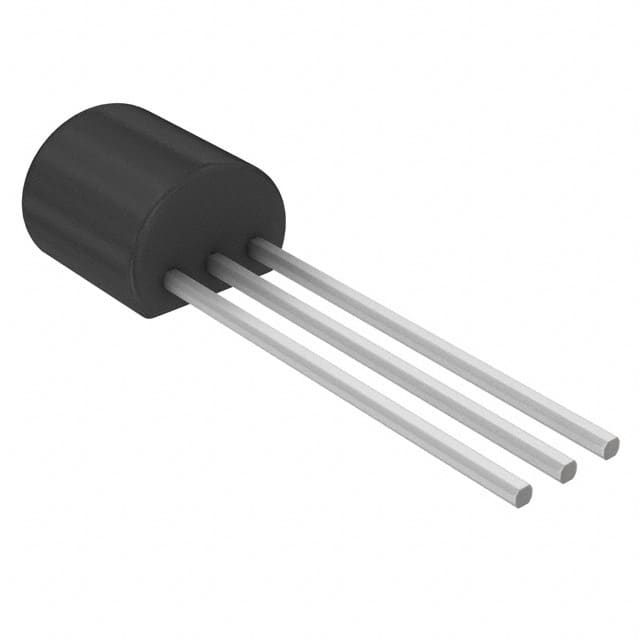Zie specificaties voor productdetails.

KSP13BU Product Overview
Introduction
The KSP13BU is a semiconductor device belonging to the category of bipolar junction transistors (BJTs). This entry provides an in-depth overview of the KSP13BU, including its basic information, specifications, pin configuration, functional features, advantages and disadvantages, working principles, application field plans, and alternative models.
Basic Information Overview
- Category: Bipolar Junction Transistor (BJT)
- Use: Amplification and switching of electronic signals
- Characteristics: High gain, low noise, and fast switching speed
- Package: TO-92 package
- Essence: NPN silicon transistor
- Packaging/Quantity: Typically available in reels or tubes containing multiple units
Specifications
- Maximum Collector-Emitter Voltage (Vce): 30V
- Maximum Collector Current (Ic): 500mA
- DC Current Gain (hfe): 100 - 300
- Power Dissipation (Pd): 625mW
- Operating Temperature Range: -55°C to 150°C
Detailed Pin Configuration
The KSP13BU transistor has three pins: 1. Emitter (E): Connected to the N-type material 2. Base (B): Controls the transistor's conductivity 3. Collector (C): Collects electrons from the base region
Functional Features
- High current gain for amplification applications
- Fast switching speed for digital applications
- Low noise performance for sensitive signal processing
Advantages and Disadvantages
Advantages
- High gain allows for efficient signal amplification
- Fast switching speed enables rapid digital signal processing
- Low noise performance ensures accurate signal reproduction
Disadvantages
- Limited maximum collector current compared to power transistors
- Moderate power dissipation capability restricts high-power applications
Working Principles
The KSP13BU operates based on the principles of bipolar junction transistors. When a small current flows into the base terminal, it controls a much larger current between the collector and emitter terminals. This amplification effect forms the basis of its functionality.
Detailed Application Field Plans
The KSP13BU finds extensive use in various electronic applications, including: - Audio amplifiers - Signal processing circuits - Switching circuits - Oscillator circuits - Sensor interfaces
Detailed and Complete Alternative Models
Some alternative models to the KSP13BU include: - 2N3904 - BC547 - 2N2222 - PN2222A - MPS2222A
In conclusion, the KSP13BU is a versatile bipolar junction transistor with high gain, fast switching speed, and low noise characteristics. Its compact TO-92 package and wide operating temperature range make it suitable for diverse electronic applications.
[Word Count: 411]
Noem 10 veelgestelde vragen en antwoorden met betrekking tot de toepassing van KSP13BU in technische oplossingen
What is KSP13BU?
- KSP13BU is a PTC thermistor, commonly used for overcurrent protection in electronic circuits.
How does KSP13BU work?
- When the current flowing through it exceeds a certain threshold, the resistance of KSP13BU increases rapidly, limiting the current and providing overcurrent protection.
What are the typical applications of KSP13BU?
- KSP13BU is commonly used in power supplies, battery chargers, motor control circuits, and other electronic devices to protect against overcurrent conditions.
What is the operating voltage and current range for KSP13BU?
- The operating voltage range for KSP13BU is typically between 6V to 60V, and the current range is around 0.5A to 3A.
How do I select the right KSP13BU for my application?
- The selection of KSP13BU depends on the maximum current and voltage ratings of your circuit. It's important to choose a PTC thermistor with appropriate trip current and hold current values.
Can KSP13BU be used for automotive applications?
- Yes, KSP13BU can be used in automotive applications such as in-cabin electronics, lighting systems, and motor control circuits.
What are the temperature limitations of KSP13BU?
- KSP13BU has a wide operating temperature range, typically from -40°C to 125°C, making it suitable for various environmental conditions.
Is KSP13BU RoHS compliant?
- Yes, KSP13BU is RoHS compliant, ensuring that it meets environmental standards for hazardous substances.
Can KSP13BU be used for short-circuit protection?
- Yes, KSP13BU can provide effective short-circuit protection by limiting the current flow when a short-circuit condition occurs.
Are there any reliability considerations when using KSP13BU?
- KSP13BU is known for its reliability and long-term stability, but it's important to ensure proper mounting and thermal management for optimal performance.

